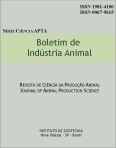Behavior analysis, from grinding or not of the teeth of piglets in nursery
Keywords:
ethology, matrices, welfareAbstract
The establishment of the social hierarchy of piglets after birth is one of the factors responsible for aggressive disputes among swine. This behavior results in lesions on the face of piglets and on the nipple of sows. Methods such as clipping or grinding of teeth procedures are conducted to the reduction of losses related to the welfare and growth performance of the animals. However, this management has been questioned about the pain and stress. Since 2001, The European Union legislation which describes patterns of animal welfare prohibits the handling of clipping or grinding of teeth of piglets as a routine measure. The objective of this study was to evaluate the effect of grinding or not of teeth in piglet behavior in the nursery. Were used to obtain the data: 34 sows and their piglets, with 11.3 on average. The study was conducted during the summer, in the city of Concordia, SC. At birth, the piglets were separated into rooms according to the order of birth and type of treatment directed to the litters. The management of tooth grind was always held on the second day postpartum along with weighing, the tail docking and castration of male piglets. The behavior was obtained with the aid of an ethogram with variables like sleeping, breastfeeding, eating and drinking water, stereotypies, aggression, standing, lying or sitting, playfulness and exploratory behavior. The observations were made during the twenty one and twenty eight days, until weaning. Data were collected in periods of three days during each week, six hours a day and every five minutes. The data were analyzed on a complete randomized block design with repeated measures. We used a mixed model with fixed effects of treatment, shift, week, and their interactions block using the MIXED procedure (SAS Inst. Inc., Cary, NC). The behavior studied is the percentage of animals in the activity when evaluated. The comparison of the mean was performed by Fisher's least significant difference. Analyzing the behavior of piglets from varying treatments, shift and week, we found an important effect in all proposals. After confronting variables such as treatment and day shift, only the behavior of eating and sitting had no significant effect. But when contrasted treatment and week, important behaviors such as exploratory and playfulness didn't show significant effect. When evaluating individual behavior the playfulness showed significant effect when related to different kinds of handling of teeth. The standing and playful behavior, important evidence of comfort and stress of animals, were the ones which had no significant effect when the variables treatment x week x shift were opposed. The stereotyped behavior, important for the welfare of confined animals, showed no significant effect only for opposing variables: week x shift and treatment, indicating a high correlation between treatment, time of confinement and lack of entertainment of confined animals. Significant effect was found for agonistic behavior in all opposing variables, indicating normal behavior of piglets, both in the early days of birth and the following weeks, due to increased body and consequent reduction in the physical space of the stall. It is concluded from the treatments that the grinding of piglets teeth in the nursery is effective for reducing aggressive behavior and there were fewer animals with injuries in pig farms.Downloads
Downloads
Published
Issue
Section
License
Os autores não serão remunerados pela publicação de trabalhos, pois devem abrir mão de seus direitos autorais em favor deste periódico. Por outro lado, os autores ficam autorizados a publicar seus artigos, simultaneamente, em repositórios da instituição de sua origem, desde que citada a fonte da publicação original seja Boletim de Indústria Animal. A revista se reserva o direito de efetuar, nos originais, alterações de ordem normativa, ortográfica e gramatical, com vistas a manter o padrão culto da língua e a credibilidade do veículo. Respeitará, no entanto, o estilo de escrever dos autores. Alterações, correções ou sugestões de ordem conceitual serão encaminhadas aos autores, quando necessário. Nesses casos, os artigos, depois de adequados, deverão ser submetidos a nova apreciação. As opiniões emitidas pelos autores dos artigos são de sua exclusiva responsabilidade. Todo o conteúdo deste periódico, exceto onde está identificado, está licenciado sob a Licença Creative Commons Attribution (CC-BY-NC). A condição BY implica que os licenciados podem copiar, distribuir, exibir e executar a obra e fazer trabalhos derivados com base em que só se dão o autor ou licenciante os créditos na forma especificada por estes. A cláusula NC significa que os licenciados podem copiar, distribuir, exibir e executar a obra e fazer trabalhos derivados com base apenas para fins não comerciais.













